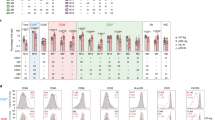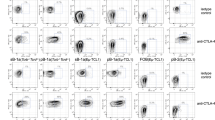Abstract
Lymphocytes typically express only one functional antigen receptor, a restriction contributed to by allelic exclusion. Here we have analyzed B lymphocyte development in offspring of a mouse generated by nuclear transfer using a single donor B lymphocyte. In this mouse, all immunoglobulin alleles were inherited as found in the donor lymphocyte. This donor cell had two rearranged immunoglobulin light chain alleles, both directing the synthesis of light chains that could form functional antigen receptors, one of which was autoreactive. Progeny mice carrying this immunoglobulin light chain allele produced mature B cells, some of which continued to express the autoreactive receptor but required another rearrangement to rescue them from negative selection. Such receptor editing failed to destroy expression of one original light chain allele, thereby recreating dual receptor expression on these surviving B cells. We suggest that autoreactive antibodies in serum of mice and humans are due in part to such 'passenger' receptors.
This is a preview of subscription content, access via your institution
Access options
Subscribe to this journal
Receive 12 print issues and online access
$209.00 per year
only $17.42 per issue
Buy this article
- Purchase on Springer Link
- Instant access to full article PDF
Prices may be subject to local taxes which are calculated during checkout




Similar content being viewed by others
References
Pernis, B., Chiappino, G., Kelus, A.S. & Gell, P.G. Cellular localization of immunoglobulins with different allotypic specificities in rabbit lymphoid tissues. J. Exp. Med. 122, 853–876 (1965).
Weiler, E. Differential activity of allelic gamma-globulin genes in antibody-producing cells. Proc. Natl. Acad. Sci. USA 54, 1765–1772 (1965).
Barreto, V. & Cumano, A. Frequency and characterization of phenotypic Ig heavy chain allelically included IgM-expressing B cells in mice. J. Immunol. 164, 893–899 (2000).
Casellas, R. et al. Contribution of receptor editing to the antibody repertoire. Science 291, 1541–1544 (2001).
Gay, D., Saunders, T., Camper, S. & Weigert, M. Receptor editing: an approach by autoreactive B cells to escape tolerance. J. Exp. Med. 177, 999–1008 (1993).
Tiegs, S.L., Russell, D.M. & Nemazee, D. Receptor editing in self-reactive bone marrow B cells. J. Exp. Med. 177, 1009–1020 (1993).
Chen, C., Prak, E.L. & Weigert, M. Editing disease-associated autoantibodies. Immunity 6, 97–105 (1997).
Pelanda, R. et al. Receptor editing in a transgenic mouse model: site, efficiency, and role in B cell tolerance and antibody diversification. Immunity 7, 765–775 (1997).
Halverson, R., Torres, R.M. & Pelanda, R. Receptor editing is the main mechanism of B cell tolerance toward membrane antigens. Nat. Immunol. 5, 645–650 (2004).
Nemazee, D. Antigen receptor 'capacity' and the sensitivity of self-tolerance. Immunol. Today 17, 25–29 (1996).
Nemazee, D.A. & Burki, K. Clonal deletion of B lymphocytes in a transgenic mouse bearing anti-MHC class I antibody genes. Nature 337, 562–566 (1989).
Goodnow, C.C. et al. Altered immunoglobulin expression and functional silencing of self-reactive B lymphocytes in transgenic mice. Nature 334, 676–682 (1988).
Retter, M.W. & Nemazee, D. Receptor editing occurs frequently during normal B cell development. J. Exp. Med. 188, 1231–1238 (1998).
Wardemann, H. et al. Predominant autoantibody production by early human B cell precursors. Science 301, 1374–1377 (2003).
Louzoun, Y., Friedman, T., Luning Prak, E., Litwin, S. & Weigert, M. Analysis of B cell receptor production and rearrangement. Part I. Light chain rearrangement. Semin. Immunol. 14, 169–190; discussion 221–222 (2002).
Coleclough, C., Perry, R.P., Karjalainen, K. & Weigert, M. Aberrant rearrangements contribute significantly to the allelic exclusion of immunoglobulin gene expression. Nature 290, 372–378 (1981).
Alt, F.W., Rosenberg, N., Enea, V., Siden, E. & Baltimore, D. Multiple immunoglobulin heavy-chain gene transcripts in Abelson murine leukemia virus-transformed lymphoid cell lines. Mol. Cell. Biol. 2, 386–400 (1982).
Wabl, M. & Steinberg, C. A theory of allelic and isotypic exclusion for immunoglobulin genes. Proc. Natl. Acad. Sci. USA 79, 6976–6978 (1982).
Nemazee, D., Martensson, A. & Verkoczy, L. Haplotype exclusion and receptor editing: irreconcilable differences? Semin. Immunol. 14, 191–198; discussion 222–224 (2002).
Imai, H. et al. Natural autoantibody against apolipoprotein A-I. Detection and characterization of the monoclonal antibody established from normal unimmunized BALB/c mice. J. Immunol. 153, 2290–2301 (1994).
Hayakawa, K. et al. Positive selection of natural autoreactive B cells. Science 285, 113–116 (1999).
Dighiero, G. et al. High frequency of natural autoantibodies in normal newborn mice. J. Immunol. 134, 765–771 (1985).
Coutinho, A., Kazatchkine, M.D. & Avrameas, S. Natural autoantibodies. Curr. Opin. Immunol. 7, 812–818 (1995).
Lacroix-Desmazes, S. et al. Self-reactive antibodies (natural autoantibodies) in healthy individuals. J. Immunol. Methods 216, 117–137 (1998).
Chai, S.K., Mantovani, L., Kasaian, M.T. & Casali, P. Natural autoantibodies. Adv. Exp. Med. Biol. 347, 147–159 (1994).
Varela, F.J. & Coutinho, A. Second generation immune networks. Immunol. Today 12, 159–166 (1991).
Diaw, L. et al. Structural and affinity studies of IgM polyreactive natural autoantibodies. J. Immunol. 158, 968–976 (1997).
Sarukhan, A., Garcia, C., Lanoue, A. & von Boehmer, H. Allelic inclusion of T cell receptor alpha genes poses an autoimmune hazard due to low-level expression of autospecific receptors. Immunity 8, 563–570 (1998).
Hochedlinger, K. & Jaenisch, R. Monoclonal mice generated by nuclear transfer from mature B and T donor cells. Nature 415, 1035–1038 (2002).
Kouskoff, V. & Nemazee, D. Role of receptor editing and revision in shaping the B and T lymphocyte repertoire. Life Sci. 69, 1105–1113 (2001).
Ritchie, K.A., Brinster, R.L. & Storb, U. Allelic exclusion and control of endogenous immunoglobulin gene rearrangement in κ transgenic mice. Nature 312, 517–520 (1984).
Yamagami, T., ten Boekel, E., Andersson, J., Rolink, A. & Melchers, F. Frequencies of multiple IgL chain gene rearrangements in single normal or κL chain-deficient B lineage cells. Immunity 11, 317–327 (1999).
Schwartz, R.C., Sonenshein, G.E., Bothwell, A. & Gefter, M.L. Multiple expression of Ig λ-chain encoding RNA species in murine plasmacytoma cells. J. Immunol. 126, 2104–2108 (1981).
Diaw, L., Siwarski, D. & Huppi, K. Double light chain producing lymphocytes: an enigma of allelic exclusion. Immunol. Res. 24, 303–310 (2001).
Chen, X., Martin, F., Forbush, K.A., Perlmutter, R.M. & Kearney, J.F. Evidence for selection of a population of multi-reactive B cells into the splenic marginal zone. Int. Immunol. 9, 27–41 (1997).
Spanopoulou, E. et al. Functional immunoglobulin transgenes guide ordered B-cell differentiation in Rag-1-deficient mice. Genes Dev. 8, 1030–1042 (1994).
Xu, H., Li, H., Suri-Payer, E., Hardy, R.R. & Weigert, M. Regulation of anti-DNA B cells in recombination-activating gene-deficient mice. J. Exp. Med. 188, 1247–1254 (1998).
Diaw, L., Siwarski, D., DuBois, W., Jones, G. & Huppi, K. Double producers of kappa and lambda define a subset of B cells in mouse plasmacytomas. Mol. Immunol. 37, 775–781 (2000).
Hardy, R.R., Dangl, J.L., Hayakawa, K., Jager, G. & Herzenberg, L.A. Frequent λ light chain gene rearrangement and expression in a Ly-1 B lymphoma with a productive κ chain allele. Proc. Natl. Acad. Sci. USA 83, 1438–1442 (1986).
Kwan, S.P., Max, E.E., Seidman, J.G., Leder, P. & Scharff, M.D. Two κ immunoglobulin genes are expressed in the myeloma S107. Cell 26, 57–66 (1981).
Goldmit, M., Schlissel, M., Cedar, H. & Bergman, Y. Differential accessibility at the κ chain locus plays a role in allelic exclusion. EMBO J. 21, 5255–5261 (2002).
Liang, H.E., Hsu, L.Y., Cado, D. & Schlissel, M.S. Variegated transcriptional activation of the immunoglobulin κ locus in pre-B cells contributes to the allelic exclusion of light-chain expression. Cell 118, 19–29 (2004).
Wabl, M.R., Brun, R.B. & Du Pasquier, L. Lymphocytes of the toad Xenopus laevis have the gene set for promoting tadpole development. Science 190, 1310–1312 (1975).
Acknowledgements
We thank F. Nasseri, M. Weigert, D. Nemazee, and E. Weiss for discussions; K. Hochedlinger and R. Jaenisch for providing nuclear transfer mice; and M. Schlissel for the human Cκ mouse generated by M. Nussenzweig. Supported by a National Institutes of Health (R01 AI41570) and a University of California Biostar Discovery Grant.
Author information
Authors and Affiliations
Corresponding author
Ethics declarations
Competing interests
The authors declare no competing financial interests.
Supplementary information
Supplementary Fig. 1
Sequence of κ light chain alleles. (PDF 231 kb)
Rights and permissions
About this article
Cite this article
Gerdes, T., Wabl, M. Autoreactivity and allelic inclusion in a B cell nuclear transfer mouse. Nat Immunol 5, 1282–1287 (2004). https://doi.org/10.1038/ni1133
Received:
Accepted:
Published:
Issue Date:
DOI: https://doi.org/10.1038/ni1133
This article is cited by
-
Innate and adaptive signals enhance differentiation and expansion of dual-antibody autoreactive B cells in lupus
Nature Communications (2018)
-
Checkpoints in lymphocyte development and autoimmune disease
Nature Immunology (2010)
-
Allelic 'choice' governs somatic hypermutation in vivo at the immunoglobulin κ-chain locus
Nature Immunology (2007)
-
Somatic hypermutation is a matter of choice
Nature Immunology (2007)
-
Receptor editing in lymphocyte development and central tolerance
Nature Reviews Immunology (2006)



